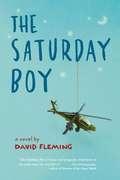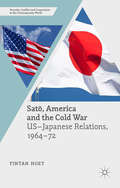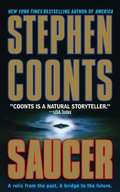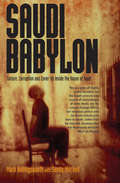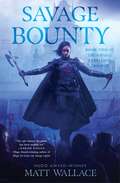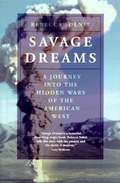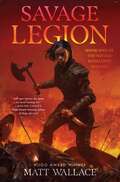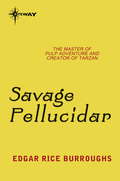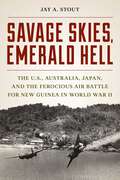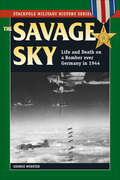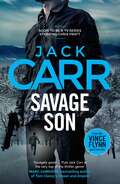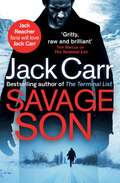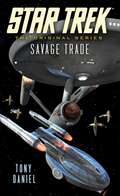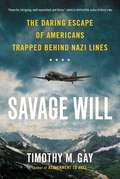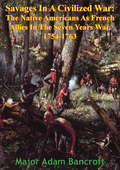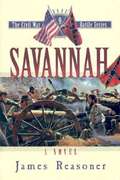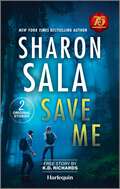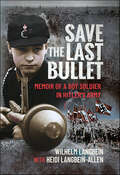- Table View
- List View
Saturday Boy
by David FlemingIf there's one thing I've learned from comic books, it's that everybody has a weakness--something that can totally ruin their day without fail. For the wolfman it's a silver bullet. For Superman it's Kryptonite. For me it was a letter. With one letter, my dad was sent back to Afghanistan to fly Apache helicopters for the U.S. army. Now all I have are his letters. Ninety-one of them to be exact. I keep them in his old plastic lunchbox--the one with the cool black car on it that says Knight Rider underneath. Apart from my comic books, Dad's letters are the only things I read more than once. I know which ones to read when I'm down and need a pick-me-up. I know which ones will make me feel like I can conquer the world. I also know exactly where to go when I forget Mom's birthday. No matter what, each letter always says exactly what I need to hear. But what I want to hear the most is that my dad is coming home.
Saturday at M.I.9: The Classic Account of the WW2 Allied Escape Organisation
by Airey NeaveThe author of Flames of Calais details life in the top-secret department of Britain&’s War Office during World War II in this military memoir. Airey Neave, who in the last two years of the war was the chief organizer at M.I.9, gives his inside story of the underground escape lines in occupied North-West Europe, which returned over 4,000 Allied servicemen to Britain during the Second World War. He describes how the escape lines began in the first dark days of German occupation and how, until the end of the war, thousands of ordinary men and women made their own contribution to the Allied victory by hiding and feeding men and guiding them to safety. Neave was the first British POW to make a &“home run&” from Colditz Castle. On his return, he joined M.I.9 adopting the code name &“Saturday.&” He also served with the Nuremburg War Crimes Tribunal. Tragically Airey Neave&’s life was cut short by the IRA who assassinated him in 1979 when he was one of Margaret Thatcher&’s closest political allies.Praise for Saturday at M.I.9&“There isn&’t a page in the book which isn&’t exciting in incident, wise in judgment, and absorbing through its human involvement.&” —The Times Literary Supplement (UK)
Satō, America and the Cold War: US-Japanese Relations, 1964–72 (Security, Conflict and Cooperation in the Contemporary World)
by Fintan HoeyUsing recently released archival material from the US and Japan, this book critically re-examines US–Japanese relations during the tenure of Satō Eisaku, Japan’s longest serving prime minister. During these critical years in the Cold War in Asia, with the Vietnam War raging and the acquisition by China of a nuclear capability, Satō closely aligned with the US. This directly contributed to his success in securing the reversion of Okinawa and other Japanese territories which had remained under US control since Japan’s surrender at the end of World War II. To accomplish this he was also forced to conclude secret agreements with President Richard Nixon, including one on nuclear weapons, which are explored fully. Satō faced the challenge of the Nixon administration’s attempts to shore up the relative decline in American power with policies at odds with allied interests. Satō successfully overcame such challenges and also laid the groundwork for Japan’s anti-nuclear policy.
Saucer #1: Saucer
by Stephen CoontsWhile working in the Sahara desert far from any settlements, a group of people discover a flying saucer that is 140,000 years old. Soon the Air Force of the US has sent a crack team; and Australian billionaire is involved in trying to steal the secrets; and those who find it end up flying it on a trip around the world. How will it all end? Is this the beginning of a new era in our history or just more of the same?
Saucer #2: The Conquest
by Stephen Coonts"In Saucer, after discovering the secrets of a 140,000-year-old spacecraft and delivering it to safety in the Air and Space Museum of the Smithsonian right alongside Lindbergh's Spirit of St. Louis, Rip Cantrell and beautiful test pilot Charley Pine think their days of high-flying extraterrestrial adventure are over. However, that will change in the sequel, Saucer: The Conquest, because someone is using top-secret information about saucer technology, information that comes from the mysterious region in Nevada known as Area 51." Meanwhile, Charley takes up flying space planes to the moon for the French lunar base project. There she discovers a world-threatening antigravity beam. The French kidnap Rip's uncle, Egg, and force him to fly a saucer hidden in Area 51 to the moon. Rip and Charley must steal the first saucer from its new home at the museum and hit the not-so-friendly skies again in order to save Uncle Egg and the world.
Saudi Arabia and the Illusion of Security (Adelphi series #348)
by J.E. PetersonFirst Published in 2005. Routledge is an imprint of Taylor & Francis, an informa company.
Saudi Babylon: Torture, Corruption and Cover-Up Inside the House of Saud
by Sandy Mitchell Mark HollingsworthWhen Sandy Mitchell was arrested for his alleged involvement in two bombings in Saudi Arabia in December 2000, he thought it was a case of mistaken identity and that he would soon be released. Instead, he spent nearly three years in jail, where he was repeatedly tortured before being forced to sign a confession and admit his guilt on Saudi television.Throughout his incarceration the Saudi authorities knew that the attacks had been committed by al-Qaeda militants. Yet they kept Mitchell in jail and refused him access to a lawyer for a year. By this time he had been sentenced to death but he was eventually released before the penalty could be imposed. Saudi Babylon is the story of a shocking miscarriage of justice. But it also reveals an even more disturbing truth: how the British government, mindful of multi-billion-pound arms sales to Saudi Arabia, virtually abandoned Mitchell by adopting a softly-softly diplomatic approach to the corrupt Saudi royal family. Based on diaries and records of meetings with ministers and officials, this is a powerful exposé of how the British government acts when one of its citizens is illegally imprisoned and tortured by a regime with which it does business.
Savage Bounty (Savage Rebellion #2)
by Matt WallaceThe sequel to the acclaimed, spellbinding epic fantasy Savage Legion by Hugo Award–winning author Matt Wallace about a utopian city with a dark secret…and the underdogs who will expose it—or die trying.The call them Savages. Brutal. Efficient. Expendable. The empire relies on them. The greatest weapon they ever developed. Culled from the streets of their cities, they take the ones no one will miss and throw them, by the thousands, at the empire&’s enemies. If they live, they fight again. If they die, well, there are always more. From Hugo Award–winning author Matt Wallace comes the much-anticipated second installment to the &“epic fantasy the genre has been waiting for&” (Sarah Gailey, Hugo Award–winning author of Magic for Liars).
Savage Crowns (Savage Rebellion #3)
by Matt WallaceThe final installment in Hugo Award–winning author Matt Wallace&’s epic and spellbinding Savage Rebellion trilogy about a utopian city with a dark secret—and the underdogs who will expose it, or die trying.The final war for the nation of Crache has begun. At the helm of the people&’s rebellion is Evie, the Sparrow General. She has been captured by the Skrian, Crache&’s vicious army, and is being brought back to the Capitol for punishment. But reinforcements are coming for her. Dyeawan, who has climbed from street urchin to Crache&’s highest seat of power through clever schemes and ruthless bloodshed, finds trouble on every front once she arrives. The rebellion approaches, and there are whispers of a martyr within the city who holds enough sway to stage a coup. If she doesn&’t act quickly, her rule will be short-lived. As the women who hold the nation&’s future meet each other from different sides of the battlefield, will they be able to find a shared vision of Crache, or will they destroy each other first?
Savage Deadlock
by Don PendletonNO-MAN'S-LANDA missing U.S. nuclear scientist resurfaces as a member of a guerrilla women's rights organization in Pakistan, raising all kinds of alarms in Washington. Armed with fissionable material--and the knowledge to use it--the scientist is soon targeted by rebel fighters determined to get their hands on the nukes at any cost.With the stability of the entire region on the line, Mack Bolan is tasked with extracting the woman and bringing her Stateside, even if she doesn't want to go. But as the rebels close in and the rights group realizes its combined weapons and skills can't compare to those of trained fighters, Bolan and his allies--a handful of Pakistani soldiers and an army officer--are forced to join the battle. Their team might be small, but the Executioner has might on his side.
Savage Dreams: A Journey into the Hidden Wars of the American West
by Rebecca SolnitSolnit offers a first-person account of her expeditions in California and Nevada, focusing on the politics and history of the Nevada Test Site and Yosemite National Park. She explores the connections between the political history of the West and its cultural history, which has been obscured by the reality of the violent past. Solnit weaves the story of the Danns, two Western Shoshone sisters who have fought the US government in an effort to reclaim their ancestral lands, into her narrative.
Savage Legion (Savage Rebellion #1)
by Matt WallaceAn epic fantasy by Hugo Award–winning author Matt Wallace about a utopian city with a dark secret…and the underdogs who will expose it, or die trying. They call them Savages. Brutal. Efficient. Expendable. The empire relies on them. The Savages are the greatest weapon they ever developed. Culled from the streets of their cities, they take the ones no one will miss and throw them, by the thousands, at the empire&’s enemies. If they live, they fight again. If they die, there are always more to take their place. Evie is not a Savage. She&’s a warrior with a mission: to find the man she once loved, the man who holds the key to exposing the secret of the Savage Legion and ending the mass conscription of the empire&’s poor and wretched. But to find him, she must become one of them, to be marked in her blood, to fight in their wars, and to find her purpose. Evie will die a Savage if she has to, but not before showing the world who she really is and what the Savage Legion can really do.
Savage Pellucidar: Pellucidar Book 7 (PELLUCIDAR)
by Edgar Rice BurroughsTwo explorers from the Earth's surface had carved themselves an empire at the Earth's core - Pellucidar.The dangers were many. Untamed tribes and vicious beasts were a constant peril, and there were times when the lives of the surface-men were at stake. But, just when things seemed hopeless, they came up with a trump card - a new weapon.What they didn't realize was that it was a weapon that could bring its makers to the brink of disaster.
Savage Skies, Emerald Hell: The U.S., Australia, Japan, and the Ferocious Air Battle for New Guinea in World War II
by Jay A. StoutWhile the Marine Corps island-hopped across the Pacific from Guadalcanal to Saipan to Iwo Jima, the U.S. Army was locked in a grueling, multiyear fight for the jungle island of New Guinea, which in Japanese hands threatened both Australia and the vital supply lines stretching to the United States. Forces under Douglas MacArthur intended to deny the Japanese this opportunity and use New Guinea as a stepping stone on the road back to the Philippines and, beyond it, Japan. A critical component of that campaign was waged in the air, where American pilots supported ground troops and took the battle to the Japanese in scattered villages and beaches, along the way fighting not only the Japanese, but also the dangers of the island&’s mountainous terrain and thick jungles, the weather, and the surrounding ocean.Savage Skies, Emerald Hell is the story of the stirring and terrible air combat that made winning the fight for New Guinea possible. It includes accounts from fighter, bomber, and transport crews—primarily George Kenney&’s Fifth Air Force—and places their actions within the broader context of strategy and tactics, also providing descriptions of equipment and the experiences of the mechanics and support men who made it all possible. It is a riveting narrative of World War II in the air, combining deep primary research and Jay Stout&’s personal experience as a fighter pilot. More than a great read, Savage Skies, Emerald Hell is an important contribution to World War II history.
Savage Sky: Life and Death on a Bomber over Germany in 1944 (Stackpole Military History Series)
by George WebsterA firsthand account of aerial warfare from a USAAF veteran who flew in fighter bombers during WWII, perfect for military aviation enthusiasts. George Webster, a flight radio operator on a B-17 during the second world war, gives readers a first person account from the inside of a bomber plane. Focusing on the 92nd Bomb Group, 8th Air Force, including missions to the Schweinfurt ball-bearing plant and Berlin, Webster&’s memoir is vivid and intimate, describing the bitter cold at high altitudes, gut-wrenching fear, lethal shrapnel from flak, and German fighters darting through the bomber formation like feeding sharks. One of the first accounts of being shot down over Sweden, The Savage Sky is as close as you can get to experiencing aerial combat while still staying firmly planted on the ground. &“If you want to know what it was really like to fly in a bomber—read this!&” —George Murdoch, Armchair Auctions
Savage Son: the gripping, thrilling and adventurous novel in the James Reece series (Terminal List #3)
by Jack Carr**SOON TO BE A TV SERIES STARRING CHRIS PRATT**'Carr writes both from the gut and a seemingly infinite reservoir of knowledge in the methods of human combat. Loved it!' Chris Hauty, bestselling author of Deep State Deep in the wilds of Siberia, a woman is on the run, pursued by a man harboring secrets – a man intent on killing her. Half a world away, James Reece is recovering from brain surgery in the Montana wilderness, slowly putting his life back together with the help of investigative journalist Katie Buranek and his longtime friend and SEAL teammate Raife Hastings. Unbeknown to them, the Russian mafia has set their sights on Reece in a deadly game of cat and mouse.In his most visceral and heart-pounding thriller yet, Jack Carr explores the darkest instincts of humanity through the eyes of a man who has seen both the best and the worst of it.Praise for Jack Carr: 'This is seriously good . . . the suspense is unrelenting, and the tradecraft is so authentic the government will probably ban it – so read it while you can!' Lee Child 'With a particular line in authentic tradecraft, this fabulously unrelenting thrill-ride was a struggle to put down' Mark Dawson 'Gritty, raw and brilliant!' Tom Marcus &‘So powerful, so pulse-pounding, so well-written – rarely do you read a debut novel this damn good&’ Brad Thor 'A powerful, thoughtful, realistic, at times terrifying thriller that I could not put down. A terrific addition to the genre, Jack Carr and his alter-ego protagonist, James Reece, continue to blow me away' Mark Greaney 'Thrilling' Publishers Weekly
Savage Son: the most gripping, thrilling adventure novel you'll read this year (Terminal List Ser. #3)
by Jack Carr**NOW AN AMAZON PRIME TV SERIES STARRING CHRIS PRATT**&‘A propulsive and compulsive series. Jack Carr&’s James Reece is the kind of guy you&’d want to have in your corner. A suspenseful and exhilarating thrill-ride. Jack Carr is the real deal&’ Andy McNab Deep in the wilds of Siberia, a woman is on the run, pursued by a man harboring secrets – a man intent on killing her. Half a world away, James Reece is recovering from brain surgery in the Montana wilderness, slowly putting his life back together with the help of investigative journalist Katie Buranek and his longtime friend and SEAL teammate Raife Hastings. Unbeknown to them, the Russian mafia has set their sights on Reece in a deadly game of cat and mouse.In his most visceral and heart-pounding thriller yet, Jack Carr explores the darkest instincts of humanity through the eyes of a man who has seen both the best and the worst of it.Praise for Jack Carr: 'This is seriously good . . . the suspense is unrelenting, and the tradecraft is so authentic the government will probably ban it – so read it while you can!' Lee Child 'Carr writes both from the gut and a seemingly infinite reservoir of knowledge in the methods of human combat. Loved it!' Chris Hauty 'With a particular line in authentic tradecraft, this fabulously unrelenting thrill-ride was a struggle to put down' Mark Dawson 'Gritty, raw and brilliant!' Tom Marcus &‘So powerful, so pulse-pounding, so well-written – rarely do you read a debut novel this damn good&’ Brad Thor 'A powerful, thoughtful, realistic, at times terrifying thriller that I could not put down. A terrific addition to the genre, Jack Carr and his alter-ego protagonist, James Reece, continue to blow me away' Mark Greaney 'Thrilling' Publishers Weekly
Savage Trade: Savage Trade (Star Trek: The Original Series)
by Tony DanielAn all-new Star Trek: Original Series novel from noted sci-fi author Tony Daniel, featuring James T. Kirk, Spock, and the crew of the U.S.S. Enterprise!The U.S.S. Enterprise under the command of Captain James T. Kirk is en route to the extreme edge of the Alpha Quadrant, and to a region known as the Vara Nebula. Its mission: to investigate why science outpost Zeta Gibraltar is not answering all Federation hailing messages. When the Enterprise arrives, a scan shows no life forms in the science station. Kirk leads a landing party and quickly discovers the reason for the strange silence—signs of a violent firefight are everywhere. Zeta Gibraltar has been completely raided. Yet there are no bodies and the entire roster of station personnel is missing… ™, ®, & © 2014 CBS Studios, Inc. STAR TREK and related marks are trademarks of CBS Studios, Inc. All Rights Reserved.
Savage Will
by Timothy M. GaySavage Will brings to life a remarkable story of perseverance, heroism, and survival: the true tale of the American medics and nurses who endured two months in Nazi-occupied Albania-and the fearless citizens and Allied intelligence officers who risked all to save them. On a cold morning in war-ravaged Sicily in 1943, men and women of the 807th Medical Air Evacuation Squadron boarded a routine flight to the Italian mainland to care for wounded soldiers. En route, their plane became lost in storm clouds looming over the Adriatic Sea, drifted hundreds of miles off course, and crash-landed in remote mountainous Albania. Stranded without proper winter clothing or weapons, the Americans were trapped hundreds blizzard-plagued miles from Allied lines in a country torn apart by rival bands of pro- and anti-German guerrillas. What followed is the most thrilling untold story of World War II-a saga that would ensnare a cast of hundreds, from President Roosevelt and top Allied intelligence officials to a host of brave Albanian Resistance fighters, the British and U. S. Mediterranean air forces, and the gritty officers sent behind enemy lines to rescue them: a dashing English lieutenant and a tenacious American captain. Hunted by German soldiers, the American castaways were forced to rely on what one survivor called their "savage will" to elude their enemy and ultimately find their way to freedom. Savage Will is a testament to a generation who defied all odds.
Savages In A Civilized War: The Native Americans As French Allies In The Seven Years War, 1754-1763
by Major Adam BancroftThe Seven Years' War was the first truly global war but it will forever be recognized in North America as the French and Indian War because of the extensive use of Native American allies by the French from 1754-1758. These irregular forces were needed to offset the massive manpower advantage the British possessed in North America, 1.5 million British colonists to 55,000 French colonists. This thesis examines the complex relationship the French had with their Indian allies who were spread throughout their territorial holdings in North America. It examines French and Indian diplomatic relations and wartime strategy, and moves to describe and form an understanding of the savage frontier warfare practiced by the Indians and its adaption by the French settlers known as la petite guerre. The thesis examines the French employment of the Indians as frontier raiders, setting the conditions for conventional army operations, and counter irregular force operations and how understanding an irregular force's culture is crucial for success. The thesis examined these cultural differences and why the Indians began to move away from the French in 1758 after the massacre of the British prisoners at the surrender of Fort William Henry. This examination of the employment of Native Americans provides a concise understanding of their use and where understanding the lessons of the past benefits the modern military officer working with partner forces today.
Savannah (The Civil War Battle Series, Book #9)
by James Reasoner[From the back cover] In the end, his devotion to duty, the bond he felt with the other men, and his hatred of the Yankees and everything they had done to the South carried him ahead. Clouds of powder smoke rolled across the battlefield, choking and blinding him, but he pressed on, fighting his way through some thick brush, until he saw the Union breastworks no more than fifty yards in front of him. All was chaos around him now, the air filled with the hum of flying lead and the rattle of musketry and the screams of hurt and dying men. Henry fired once, twice, as he ran forward. He was blinded for a second by the smoke, then it cleared and revealed to him the Yankees firing over the barriers of earth and stone and logs. The leading edge of the Confederate attack reached the breastworks and surged up and over them. Flags from both sides waved above the mass of fighting and dying humanity, bits of cloth darting back and forth, weaving around each other as if they were doing battle along with the men who carried them. Henry screamed incoherently as he reached the breastworks and started to clamber up them. He thrust the pistol toward the blue-clad shapes that swam before his eyes and pulled the trigger. The gun bucked in his hand. He pulled the hammer back and fired again, repeating the near-mindless action until the pistol was empty. The hammer may have clicked harmlessly on an empty chamber several times before Henry realized what was happening; he never knew for certain about that. But he knew in this bloody madness that he would never have a chance to reload. He jammed the empty gun behind his belt and reached for a saber some officer had dropped. Union, Confederate, it didn't matter. All that was important was that the blade was sharp enough to hack the life out of the enemy, to cut through flesh and spill blood . . . Henry's hand had just closed over the saber's grip when something smashed into his head and sent him tumbling backward into darkness.
Save Me: Heart Pounding Romantic Suspense
by Sharon Sala K.D. RichardsSave Me by New York Times bestselling author Sharon SalaTragedy separated them. Now he&’s her only hope.Hunter Gray and Lainie Mayes were each other&’s first, last and only love. Until tragedy and their feuding families drove them apart. Eleven years vanish when Hunter learns that Lainie has gone missing in the Colorado mountains. Now the former army pilot must pull off his most perilous mission. Can he rescue Lainie and uncover the truth before the woman he loves is once again lost to him…this time forever?FREE BONUS STORY INCLUDED IN THIS VOLUME!Silenced Witness by bestselling author K.D. RichardsAfter her brother dies under a cloud of suspicion, Alexis Douglas will do whatever it takes to clear his name. Enlisting the help of TJ Roman proves a double-edged sword. Her brother&’s onetime best friend, the ex-military PI can&’t afford any missteps. Alexis&’s safety is all that matters, despite the powerful attraction drawing them closer. Up against a killer desperate to keep the truth buried, TJ must step up his game before he and Alexis are both silenced forever.Don&’t miss the complete Harlequin 75th Anniversary Collection: Taming a Heartbreaker by Brenda Jackson No Turning Back by Lindsay McKenna Rancher&’s Law by Diana Palmer Save Me by Sharon Sala A Murderer Among Us by Heather Graham A Beach House Beginning by RaeAnne Thayne Renegade Wife by B.J. Daniels Tying the Knot by Brenda Novak
Save the Last Bullet: Memoir of a Boy Soldier in Hitler's Army
by Heidi Langbein-Allen Wilhelm LangbeinWilli Langbein was just thirteen when the Nazis took him away from his parents under the pretense of protecting him. Their real reason was to turn him into cannon-fodder for use against Hitler’s enemies. Deployed to the collapsing Eastern Front in the last days of the war, Willi, now aged fourteen, and his schoolmates were ordered to stave off the relentless Russian advance. None were expected to return alive from the final battles of the Third Reich. Yet, against all odds, Willi does survive but his ordeal is far from over. He returns home to find everything he knows destroyed. Numb and confused, he is mandated to serve one year of forced farm labor. After his release, he gradually realizes that all he was taught to believe in was a lie and he sinks into depression. Eventually, thanks to his friendship with a kind British soldier, he begins to heal. It begins to dawn on him that he can play a part to ensure that the evil he witnessed is never repeated. Ultimately, he succeeds by earning the Medal of European Merit in 1979 for his contribution to the advancement of European democracy. Willi’s graphic and moving story, told from a Nazi child soldier’s perspective, is an inspiring memoir of lost innocence and despair, but also of determination and hope restored.
Saved by the SEAL (Battle Scars #2)
by Diana GardinHe saved her life. She showed him how to live it . . . When he sees a woman drowning, Grisham Abbot immediately leaps into action. The Navy SEAL forgets his training, his past, and the explosion that forever scarred his body and his mind. He can only remember what he was born to do. But saving Greta Owen is a complication Grisham is definitely not ready for. She's stunning and gorgeous-like sunlight after months of darkness. Yep, Grisham is so, so screwed. Greta knows that the smart thing to do would be to run from Grisham. He's a wounded warrior, and his head is a big-time mess. The problem is that Greta wants to make him her mess. One kiss and she's completely in over her head. And if this SEAL risked himself to save her, then she must find a way to bring him back to life . . .
Saved: A War Reporter's Mission to Make It Home
by Benjamin HallWhen veteran war reporter Benjamin Hall woke up in Kyiv on the morning of March 14, 2022, he had no idea that, within hours, Russian bombs would nearly end his life. As a journalist for Fox News, Hall had worked in dangerous war zones like Syria and Afghanistan, but with three young daughters at home, life on the edge was supposed to be a thing of the past. Yet when Russia viciously attacked Ukraine in February 2022, Hall quickly volunteered to go. A few weeks later, while on assignment, Hall and his crew were blown up in a Russian strike. With Hall himself gravely injured and stuck in Kyiv, it was unclear if he would make it out alive. <p><p>This is the story of how he survived—a story that continues to this day. For the first time, Hall shares his experience in full—from his ground-level view of the war to his dramatic rescue to his arduous, and ongoing, recovery. Going inside the events that have permanently transformed him, Hall recalls his time at the front lines of our world’s conflicts, exploring how his struggle to step away from war reporting led him back one perilous last time. Featuring nail-biting accounts from the many people across multiple countries who banded together to get him to safety, Hall offers a stunning look at complex teamwork and heartfelt perseverance that turned his life into a mission. <p><p>Through it all, Hall’s spirit has remained undaunted, buoyed by that remarkable corps of people from around the world whose collective determination ensured his survival. <p><p>Evocative, harrowing, and deeply moving, Saved is a powerful memoir of family and friends, of life and healing, and of how to respond when you are tested in ways you never thought possible.Benjamin Hall’s memoir includes a 16-page color photo insert. <p> <b>New York Times Bestseller</b>
